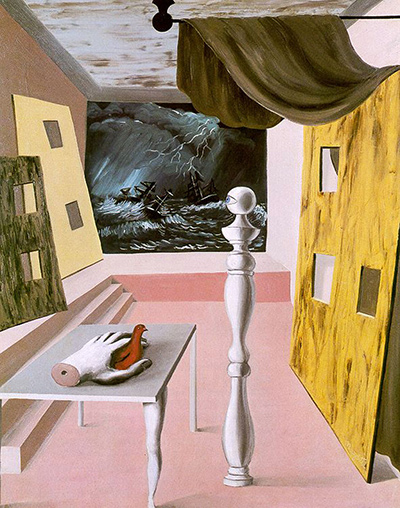The Difficult Crossing is a marvellous work of art by Belgian surrealist artist René Magritte.
Originally completed in 1926, The Difficult Crossing still engages audiences in today's society. Like many surrealist painters, Magritte painted many strange objects in his work. These can also be found in The Difficult Crossing. In the original 1926 version, the biloquet (which first appears in his piece The Lost Jockey) can be seen prominently in the scene.
The biloquet is given the human feature of an eye, which adds to Magritte's ideas of perception. This is also reinforced by the image of a storm in the background of the painting. Other bizarre objects in the painting include what appears to be the hand of a mannequin upon a table. The hand is gently clutching a red bird. The bird looks in the direction of the biloquet; the biloquet looks in the direction of the bird, but not directly at it. All of the objects appear to be laid out in a simple room, along with what seem to be wooden boards with pieces cut out. A sole curtain drapes over one of the boards.
Each object seems to play with the idea of perception. For years the image of a curtain has often been used as a metaphor for hiding, yet in The Difficult Crossing, it has been drawn back, as if to reveal something. The holes shown in the board could represent the holes or the uncertainty of human perception.
In the later version of the piece, Magritte uses the same style of oil on canvas (as with the original), however the scene has changed and is now outside in a storm similar to the one seen in the background of the original piece. The biloquet still appears, however this time is made even more human-like with it wearing a suit and an eye. There has been many a discussion on whether or not the 1963 version is a biloquet or a person. Magritte engages his audience with these ambiguities and gets them thinking about his themes of perception.




